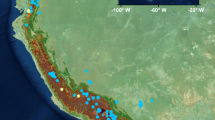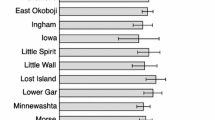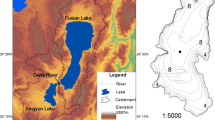Abstract
Lake George is a highly monitored, oligotrophic lake that experiences widespread tourism in the summer months. The southern basin has more shoreline development than the northern basin, resulting in a south to north gradient of anthropogenic impairment. This study aimed to assess differences in nearshore diatom communities regarding gradients of water chemistry and watershed development throughout the lake. Using redundancy analyses, water chemistry explained more variation within diatom assemblages than watershed variables. Seasonal comparisons of watershed types, based on development, revealed SPC values to be significantly higher in the southern basin in all three seasons (spring, summer, and autumn). Among the three seasons, summer demonstrated the best potential for further monitoring of diatom communities with the north and south basins demonstrating differences in Shannon–Weiner (H′) diversity index values and proportions of Asterionella formosa, Fragilaria crotonensis, and Lindavia lemanensis. Dominant diatoms from previous studies in the lake were compared to present populations and showed a concomitant reduction in Stephanodicus spp. and Melosira spp. while smaller centric species continue to increase. Given the differences between the two basins, climate change is likely to manifest differently in the southern, more productive basin than the northern basin.





Similar content being viewed by others
Data availability
The datasets generated and/or analyzed during the current study are not publicly available due private ownership of Rensselaer Polytechnic Institute and IBM, but are available from the corresponding author on reasonable request.
References
APHA (American Public Health Association), 1995. In Greenberg, A.E. (ed.), Standard Methods for the Examination of Water and Wastewater. American Public Health Association, Washington, DC.
Beck, M. & L. Hatch, 2009. A review of research on the development of lake indices of biotic integrity. Environmental Reviews 17: 21–44.
Bourbonniere, R. A. & P. A. Meyers, 1996. Sedimentary geolipid records of historical changes in the watersheds and productivities of Lakes Ontario and Erie. Limnology and Oceanography 41: 352–359.
Boylen, C., L. Eichler, M. Swinton, S. Nierzwicki-Bauer, I. Hannoun & J. Short, 2014. The state of the lake: thirty years of water quality monitoring on Lake George, New York 1980–2009. Retrieved from https://lakegeorgetown.org/wp-content/uploads/2015/10/2014-The-State-of-the-Lake.pdf.
Bradshaw, E. G., N. J. Anderson, J. P. Jensen & E. Jeppesen, 2002. Phosphorus dynamics in Danish lakes and the implications for diatom ecology and palaeoecology. Freshwater Biology 47: 1963–1975.
Camburn, K.E. & D.F. Charles, 2000. In Spamer, E.E. (eds), Diatoms of Low-Alkalinity Lakes in the Northeastern United States. The Academy of Natural Sciences of Philadelphia, Philadelphia, PA.
Cammack, W. K. L., J. Kalff & E. Smith, 2004. Flourescent dissolved organic matter in lakes: relationships with heterotrophic metabolism. Limnology and Oceanography 49: 2034–2035.
Charles, D. F., D. R. Whitehead, D. S. Anderson, R. Bienert, K. E. Camburn, R. B. Cook, T. L. Crisman, R. B. Davis, J. Ford, B. D. Fry, R. A. Hites, J. S. Kahl, J. C. Kingston, R. G. Kreis Jr., M. J. Mitchell, S. A. Norton, L. A. Roll, J. P. Smol, P. R. Sweets, A. J. Utala, J. R. White, M. C. Whiting & R. J. Wise, 1986. The PIRLA project (paleoecological investigation of recent lake acidification): Preliminary results for the Adirondacks, New England, N. Great Lakes states, and N. Florida. Water, Air, & Soil Pollution 30: 355–365.
Cooke, S. L., C. E. Williamson, B. R. Hargraves & D. P. Morris, 2006. Beneficial and detrimental interactive effects of dissolved organic matter and ultraviolet radiation on zooplankton in a transparent lake. Hydrobiologia 568: 15–28.
Cottingham, K. L., J. A. Rusak & P. R. Leavitt, 2000. Increased ecosystem variability and reduced predictability following fertilization: evidence from paleolimnology. Ecology Letters 3: 340–348.
DelPrete, A. & R. A. Park, 1981. Postglacial history of Lake George based on diatoms in sediment cores. In Boylen, C. W. (ed), The Lake George Ecosystem, Vol. 1. Lake George Association, Lake George, NY.
Dixit, S. S., J. P. Smol, J. C. Kingston & D. F. Charles, 1992. Diatoms: powerful indicators of environmental change. Environmental Science & Technology 26: 23–33.
Dixit, S. S., J. P. Smol, D. F. Charles, R. M. Hughers, S. Paulsen & G. Collins, 1999. Assessing water quality changes in the lakes of the northeastern United States using sediment diatoms. Canadian Journal of Fisheries and Aquatic Sciences 56: 131–152.
Dixit, S. S., A. S. Dixit, J. P. Smol, R. M. Hughes & S. G. Paulsen, 2000. Water quality changes from human activities in three northeastern USA lakes. Lake and Reservior Management 16: 305–321.
Dodds, W. K., W. W. Bouska, J. L. Eitzmann, T. J. Pilger, K. L. Pitts, A. J. Riley, J. T. Schloesser & D. J. Thornbrugh, 2009. Eutrophication of U.S. freshwaters: analysis of potential economic damages. Environmental Science & Technology 43: 12–19.
Engstrom, D. R., E. B. Swain & J. C. Kingston, 1985. A paleolimnological record of human disturbance from Harvey’s Lake, Vermont: geochemistry, pigments and diatoms. Freshwater Biology 15: 261–288.
Falkowski, P. G. & M. J. Oliver, 2007. Mix and match: how climate selects phytoplankton. Nature Reviews Microbiology 5: 813–819.
Fenneman, N. M., 1938. Physiography of Eastern United States, McGraw-Hill Book Company, New York/London:, 408.
Foley, B., I. D. Jones, S. C. Maberly & B. Rippey, 2012. Long-term changes in oxygen depletion in a small temperate lake: effects of climate change and eutrophication. Freshwater Ecology 57: 278–289.
Fore, L. S., J. R. Karr & R. W. Wisseman, 1996. Assessing invertebrate responses to human activities: evaluating alternative approaches. Journal of the North American Benthological Society 15: 212–231.
Friberg, N., N. Bonada, D. C. Bradley, M. J. Dunbar, F. K. Edwards, J. Grey, R. B. Hayes, A. G. Hildrew, N. Lamouroux, M. Trimmer & G. Woodward, 2011. Biomonitoring of human impacts in freshwater ecosystems: the good, the bad and the ugly. Advances in Ecological Research 44: 1–68.
Hall, R. I. & J. P. Smol, 2010. Diatoms as indicators of lake eutrophication. In Smol, J. P. & E. F. Stoermer (eds), The Diatoms: Applications for the Environmental and Earth Sciences Cambridge University Press, Cambridge: 122–151.
Hintz, W. D., B. M. Mattes, M. S. Schuler, D. K. Jones, A. B. Stoler, L. Lind & R. A. Relyea, 2017. Salinization triggers a trophic cascade in experimental freshwater communities with varying food-chain length. Ecological Applications 27: 833–844.
Hintz, W. D., M. S. Schuler, J. J. Borreli, L. W. Eichler, A. B. Stoler, V. W. Moriarty, L. E. Ahrens, C. W. Boylen, S. A. Nierzwicki-Bauer & R. A. Relyea, 2020. Concurrent improvement and deterioration of epilimnetic water quality in an oligotrophic lake over 37 years. Limnology and Oceanography. https://doi.org/10.1002/lno.11359.
Holdren, G. R., Jr., T. M. Brunelle, G. Matisoff & M. Wahlen, 1984. Timing the increase in atmospheric sulphur deposition in the Adirondack Mountains. Nature 311: 245–248.
Hutchinson, D. R., W. M. Ferrebee, H. J. Knebel, R. J. Wold & Y. W. Isachsen, 1981. The sedimentary framework of the southern basin of Lake George, New York. Quaternary Research 15: 44–61.
Johnston, C. A., N. A. Detenbeck & G. J. Niemi, 1990. The cumulative effect of wetlands on stream water quality and quantity: a landscape approach. Biogeochemistry 10: 105–141.
Judd, K. E., H. E. Adams, N. S. Bosch, J. M. Kostrzewski, C. E. Scott, B. M. Schultz, D. H. Wang & G. W. Kling, 2005. A case history: effects of mixing regime on nutrient dynamics and community structure in Third Sister Lake, Michgan during late winter and early spring 2003. Lake and Reservoir Management 21: 316–329.
Kane, D. D., S. I. Gordon, M. Munawar, M. N. Charlton & D. A. Culver, 2009. The planktonic index of biotic integrity (P-IBI): an approach for assessing lake ecosystem health. Ecological Indicators 9: 1234–1247.
Karr, J. R., 1981. Assessment of biotic integrity using fish communities. Fisheries 6: 21–27.
Karraker, N. E., J. P. Gibbs & J. R. Vonesh, 2008. Impacts of road deicing salt on the demography of vernal pool-breeding amphibians. Ecological Applications 18: 724–734.
Karst-Riddoch, T. L., M. F. J. Pisaric & J. P. Smol, 2005. Diatom responses to 20th century climate-related environmental changes in high-elevation mountain lakes of the northern Canadian Cordillera. Journal of Paleolimnolgy 33: 265–282.
Kelly, M. G. & B. A. Whitton, 1995. The trophic diatom index: a new index for monitoring eutrophication in rivers. Journal of Applied Phycology 7: 433–444.
Kireta, A. R., E. D. Reavie, N. P. Danz, R. P. Axler, G. V. Sgro, J. C. Kingston, T. N. Brown & T. Hollenhurst, 2007. Coastal geomorphic and lake variability in the Laurentian Great Lakes: implications for a diatom-based monitoring tool. Journal of Great Lakes Research 33: 136–153.
Kissman, C. E. H., C. E. Williamson, K. C. Rose & J. E. Saros, 2013. Response of phytoplankton in an alpine lake to inputs of dissolved organic matter through nutrient enrichment and trophic forcing. Limnology and Oceanography 58: 867–880.
Krammer, K. & H, Lange-Bertalot, 1986, 1988, 1991, 1997. Bacillariophycae. In Ettl, J., J. Gerloff, H. Hyenig & D. Mollen-hauer (eds), Susswasserflora von Mitteleuropa 2/1–4. Fischer, Stuttgart.
Kuefner, W., A. Hofmann, S. Ossyssek, N. Dubois, J. Geist & U. Raeder, 2020. Composition of highly diverse diatom community shifts as response to climate change: a down-core study of 23 central European mountain lakes. Ecological Indicators 117: 1–13.
Lathrop, R. C., 2007. Perspectives on the eutrophication of the Yahara lakes. Lake and Reservoir Management 23: 345–365.
Lathrop, R. C., S. R. Carpenter & D. M. Robertson, 1999. Water clarity responses to phosphorus, Daphnia grazing, and internal mixing in Lake Mendota. Limnology and Oceanography 44: 137–146.
Lind, L., M. S. Schuler, W. D. Hints, A. B. Stoler, D. K. Jones, B. M. Mattes & R. A. Relyea, 2018. Salty fertile lakes: how salinization and eutrophication alter the structure of freshwater communities. Ecosphere 9: 1–19.
Lotter, A. F. & C. Bigler, 2000. Do diatoms in the Swiss Alps reflect length of ice cover? Aquatic Sciences 62: 125–141.
Lotter, A. F., R. Pienitz & R. Schmidt, 2010. Diatoms as indicators of environmental change in subarctic and alpine regions. In Smol, J. P. & E. F. Stoermer (eds), The Diatoms: Applications for the Environmental and Earth Sciences Cambridge University Press, Cambridge: 231–248.
Marchetto, A., A. Lamia, S. Musazzi, J. Massaferro, L. Langone & P. Guilizzoni, 2003. Lake Maggiore (N. Italy) trophic history: fossil diatom, plant pigments, and chironomids, and comparison with long-term limnological data. Quaternary International 113: 97–110.
Maslennikova, A. V., 2020. Development and application of an electrical conductivity transfer function, using diatoms from lakes in the Urals, Russia. Journal of Paleolimnology 63: 129–146.
Mayer, L. M., L. L. Schick & T. C. Loder III., 1999. Dissolved protein fluorescence in two Main estuaries. Marine Chemistry 64: 171–179.
Messina, N. J., R. M. Couture, S. A. Norton, S. D. Birkel & A. Amirbahman, 2020. Modeling response of water quality parameters to land-use and climate change in a temperate, mesotrophic lake. Science of the Total Environment. https://doi.org/10.1016/j.scitotenv.2020.136549.
Mushet, G. R., K. Flear, B. Wiltse, A. M. Paterson & B. F. Cumming, 2017. Increased relative abundance of colonial scaled chrysophytes since pre-industrial times in minimally disturbed lakes from the Experimental Lakes Area, Ontario. Canadian Journal of Fisheries and Aquatic Sciences 75: 1465–1476.
Patrick, R., 1949. A proposed biological measure of stream conditions based on a survey of Conestoga Basin, Lancaster County, Pennsylvania. Proceedings of the Academy of Natural Science of Philadelphia 101: 277–341.
Ptacnik, R., A. G. Solimini, T. Anderson, T. Tamminen, P. Brettum, L. Lepistö, E. Willén & S. Rekolainen, 2008. Diversity predicts stability and resource use efficiency in natural phytoplankton communities. Proceedings of the National Academy of Sciences 105: 5134–5138.
R Core Team, 2019. R: A language and environment for statistical computing. R Foundation for Statistical Computing, Vienna, Austria. URL https://www.R-project.org/.
Ramakrishna, D. M. & T. Viraraghavan, 2005. Environmental impact of chemical deicers – a review. Water, Air, and Soil Pollution 166: 49–63.
Reavie, E. D., R. P. Axler, G. V. Sgro, N. P. Danz, J. C. Kingston, A. P. Kireta, T. N. Brown, T. P. Hollenhorst & M. J. Ferguson, 2006. Diatom-based weighted-averaging transfer functions for Great Lakes coastal water quality: relationships to watershed characteristics. Journal of Great Lakes Research 32: 321–347.
Round, F. E., R. M. Crawford & D. G. Mann, 1990. The Diatoms: Biology and Morphology of the Genera, Cambridge University Press, Cambridge:
Sathicq, M. B., M. M. N. Gelis & J. Cochero, 2019. OPTIMOS PRIME: an R package for autoecological (optima and tolerance range) data calculation. bioRxiv 654152; https://doi.org/10.1101/654152.
Schneider, W. A., D. Jeffries & P. J. Dillon, 1979. Effects of acidic precipitation on Precambrian freshwaters in southern Ontario. Journal of Great Lakes Research 5: 45–51.
Sgro, G. V., E. D. Reavie, J. C. Kingston, A. R. Kireta, M. J. Ferguson, N. P. Danz & J. R. Johansen, 2007. A diatom quality index from a diatom-based total phosphorus inference model. Environmental Bioindicators 2: 15–34.
Shuster, E. L., 1994. The hydrogeology of the Lake George drainage basin, southeastern Adirondack Mountains, New York. PhD Dissertation. Rensselaer Polytechnic Institute, Troy, New York: 246 pp.
Siver, P. A. & P. B. Hamilton, 2011. In H. Lange-Bertalot (ed.), Diatoms of North America: The Freshwater Flora of Waterbodies on the Atlantic Coastal Plain. A.R.G. Ganter Verlag Kommanditgesellschaft, Kӧnigstein.
Sochuliaková, L., E. Skienkiewicz, L. Hamerlík, M. Svitok, D. Fidlerová & P. Bitušík, 2018. Reconstructing the trophic history of an alpine lake (High Tatra Mts.) using subfossil diatoms: disentangling the effects of climate and human influence. Water, Air, and Soil Pollution 229: 289.
Sommer, U., 1986. The periodicity of phytoplankton in Lake Constance (Bodense) in comparison to other deep lakes of central Europe. Hydrobiologia 138: 1–7.
Stager, J. C., B. F. Cumming, K. R. Laird, A. Garrigan-Piela, N. Pederson, B. Wiltse, C. S. Lane, J. Nester & A. Ruzmaikin, 2016. A 1600-year diatom record of hydroclimate variability from Wolf Lake, New York. The Holocene 27: 1–12.
Stevenson, J. R., Y. Pan & H. van Dam, 2010. Assessing environmental conditions in rivers and streams with diatoms. In Smol, J. P. & E. F. Stoermer (eds), The Diatoms: Applications for the Environmental and Earth Sciences Cambridge University Press, Cambridge: 57–84.
Stockner, J. G. & B. W. Woodruff, 1967. The succession of diatom assemblages in the recent sediments of Lake Washington. Limnology and Oceanography 12: 513–532.
Sutherland, J.W., Bloomfield, J.A., & J.M. Swart, 1983. Final Report: Lake George Urban Runoff Study, National Urban Runoff Program. Bureau of Water Research, New York State Department of Environmental Conservation, Albany, New York: 84 pp.
ter Braak, C. J. F. & P. Šmilauer, 2018. Canoco Reference Manual and User’s Guide: Software for Ordination (version 5.10), Microcomputer Power, Ithaca, NY:, 536.
Tillmann, D., 1982. Response Competition and Community Structure, Princeton University Press, Princeton, NY:
van Dam, H., A. Mertens & J. Sinkeldem, 1994. A coded checklist and ecological indicator values of freshwater diatoms from the Netherlands. Netherlands Journal of Aquatic Ecology 28: 117–133.
Watson, V. J., O. L. Loucks & W. Wojner, 1981. The impact of urbanization on seasonal hydrologic and nutrient budgets of a small North American watershed. Hydrobiologia 77: 87–96.
Weather.gov, 2021. Climate – National Weather Serive – National Oceanic and Atmospheric Administration. http://weather.gov/wrh/climate.
Stearns & Wheler, 2001. Total Phosphorus Budget Analysis, Lake George Watershed, New York. Stearns & Wheler, Cazenovia, NY. Prepared for the Lake George Park Commission.
Williams, S.L. & N.L. Clesceri, 1972. Diatom population changes in Lake George, NY. Final Report: Office of Water Resources Research – Dept. of the Interior Contract 14-31-001-3387. 212 pp.
Williamson, C. E., D. P. Morris, M. Pace & O. Olson, 1999. Dissolved organic carbon and nutrients as regulators of lake ecosystems: resurrection of a more integrated paradigm. Limnology and Oceanography 44: 795–803.
Winder, M., J. E. Reuter & S. G. Schladow, 2009. Lake warming favours small-sized planktonic diatom species. Proceedings of the Royal Society B 276: 427–435.
Acknowledgements
This work was supported by the Jefferson Project at Lake George, which is a collaboration between Rensselaer Polytechnic Institute, IBM, and The FUND for Lake George.
Author information
Authors and Affiliations
Corresponding author
Ethics declarations
Conflict of interest
The authors declare that they have no conflict of interest.
Additional information
Handling editor: Judit Padisák
Publisher's Note
Springer Nature remains neutral with regard to jurisdictional claims in published maps and institutional affiliations.
Supplementary Information
Below is the link to the electronic supplementary material.
Rights and permissions
About this article
Cite this article
Ruka, A.T., Johansen, J.R., Leps, J. et al. Seasonal diatom community responses to development and climate change in Lake George, an oligotrophic lake in the Adirondack Mountains. Hydrobiologia 849, 2761–2780 (2022). https://doi.org/10.1007/s10750-022-04892-y
Received:
Revised:
Accepted:
Published:
Issue Date:
DOI: https://doi.org/10.1007/s10750-022-04892-y




